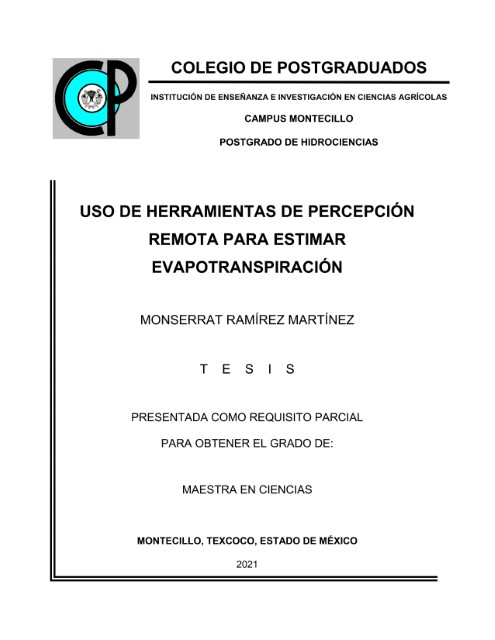
Fecha: 2021-12
MONSERRAT RAMÍREZ MARTÍNEZ , M. C. Colegio de Postgraduados, 2021
RESUMEN
Introducción. La administración del agua en la agricultura
sigue siendo el tema central en el uso eficiente en México. El estado de Hidalgo
recibe el agua tratada de la tercera planta de tratamiento más grande del mundo
para abastecer el riego de tres de los principales distritos de riego. El
objetivo de este trabajo fue describir el proceso para estimar la
evapotranspiración real de un cultivo, usando la herramienta de percepción
remota METRIC EEflux y comparar los resultados de la evapotranspiración con el
modelo Hargreaves-Samani. Metodología. Se utilizaron 12 imágenes de satélite
Landsat 7 para estimar evapotranspiración puntual usando METRIC EEflux. Para
analizar los resultados se usó el modelo Hargraves-Samani para estimar la misma
variable usando normales climatologías. Resultados. Se calcularon los valores de
Evapotranspiración real del cultivo de maíz, bajo riego mediante percepción
remota en un total de 2630 ha cultivadas oscilando entre 0.51 y 4.28 (mm/día);
los resultados por medio del método Hargreaves-Samani, se encuentran en el
intervalo 1.93 y 5.48 (mm/día). Los resultados indican que ambas metodologías
son útiles en la estimación de los requerimientos de riego por los cultivos.
Conclusión. La metodología mediante percepción remota es una herramienta robusta
no solo en la estimación de requerimiento de riego en zonas agrícolas, sino que
una vez calculada y desplegada en un sistema de información geográfica, abre
posibilidades al monitoreo y gestión de los recursos, en especial el hídrico. Y
sus resultados al ser comparados no mostraron una discrepancia notable que haga
dudar de su eficiencia.
Palabras Clave: METRIC, Evapotranspiración, Hargraves-Samani, recurso hídrico.
USE OF REMOTE PERCEPTION TOOLS TO ESTIMATE EVAPOTRANSPIRATION WASTEWATER
ABSTRACT
Introduction. The administration of water in the agriculture continues to be the central affair about the efficiemtussing in Mexico. The state of Hidalgo receives residual water from the third largest treatment plant in the world to supply the irrigation to three of the main irrigation districts. The objective of this work was to describe the process to estimate the real evapotranspiration of a crop, using the remote sensing tool METRIC EEflux and comparimg the evapotranspiration results with the Hargreaves-Samani model. Methodology. Twelve Landsat 7 satellite images were used to estimate the point evapotranspiration using METRIC EEflux metod. To analyze the results, the HargravesSamani model was used to estimate it using normal climatologies statements. Results. . The real Evapotranspiration values of the corn crop were calculated, under irrigation by remote sensing in a total of 2630 cultivated ha, ranging between 0.51 and 4.28 (mm / day); the results by means of the Hargreaves-Samani method, are in the interval 1.93 and 5.48 (mm / day). The results indicate that both methodologies are useful in estimating irrigation requirements for crops. Conclusion. The remote by sensing methodology is a robust tool that not only in estimating the irrigation requirement in agricultural areas, but once calculated and deployed in a geographic information system, it opens possibilities for the monitoring and management of resources, especially water resources. And their results when compared did not show a notable discrepancy that casts doubts on their efficiency.
Key Words: METRIC, Evapotranspiration, Hargraves-Samani, water resource .